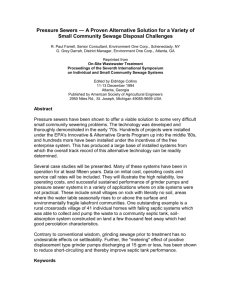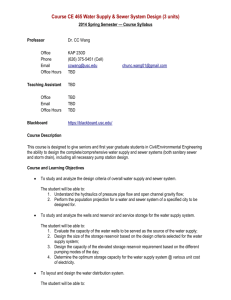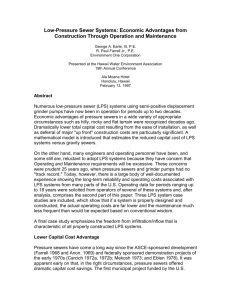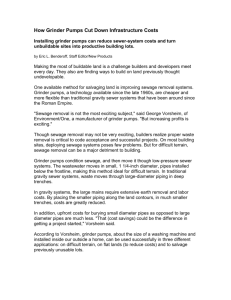Low Pressure Sewer in Lake Community
advertisement
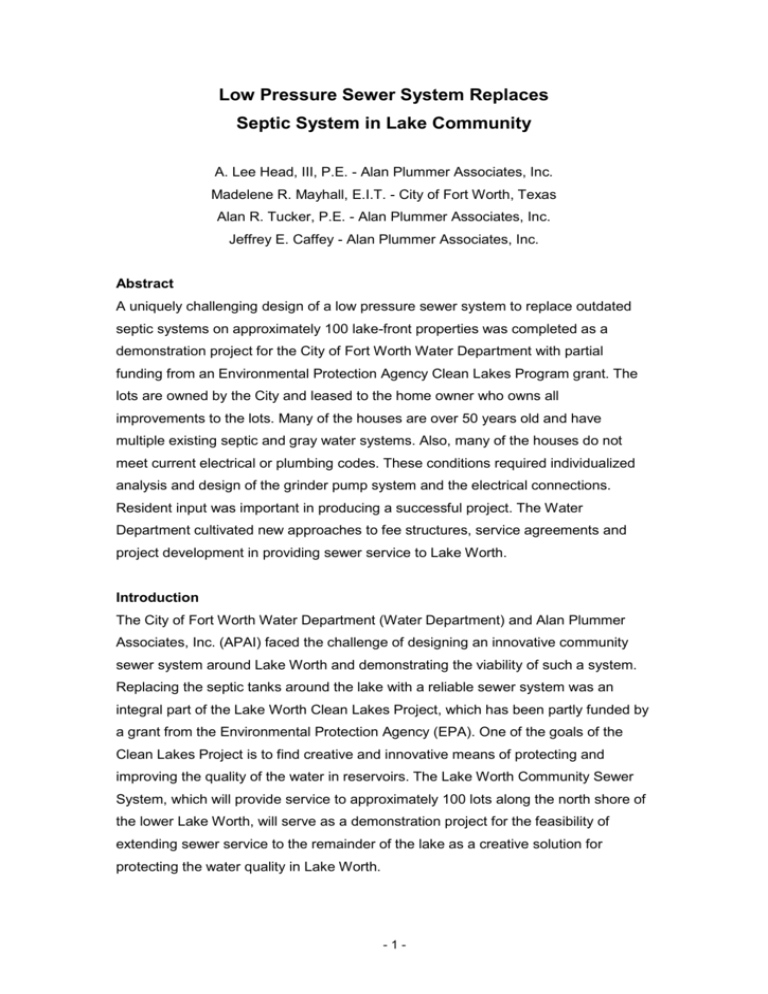
Low Pressure Sewer System Replaces Septic System in Lake Community A. Lee Head, III, P.E. - Alan Plummer Associates, Inc. Madelene R. Mayhall, E.I.T. - City of Fort Worth, Texas Alan R. Tucker, P.E. - Alan Plummer Associates, Inc. Jeffrey E. Caffey - Alan Plummer Associates, Inc. Abstract A uniquely challenging design of a low pressure sewer system to replace outdated septic systems on approximately 100 lake-front properties was completed as a demonstration project for the City of Fort Worth Water Department with partial funding from an Environmental Protection Agency Clean Lakes Program grant. The lots are owned by the City and leased to the home owner who owns all improvements to the lots. Many of the houses are over 50 years old and have multiple existing septic and gray water systems. Also, many of the houses do not meet current electrical or plumbing codes. These conditions required individualized analysis and design of the grinder pump system and the electrical connections. Resident input was important in producing a successful project. The Water Department cultivated new approaches to fee structures, service agreements and project development in providing sewer service to Lake Worth. Introduction The City of Fort Worth Water Department (Water Department) and Alan Plummer Associates, Inc. (APAI) faced the challenge of designing an innovative community sewer system around Lake Worth and demonstrating the viability of such a system. Replacing the septic tanks around the lake with a reliable sewer system was an integral part of the Lake Worth Clean Lakes Project, which has been partly funded by a grant from the Environmental Protection Agency (EPA). One of the goals of the Clean Lakes Project is to find creative and innovative means of protecting and improving the quality of the water in reservoirs. The Lake Worth Community Sewer System, which will provide service to approximately 100 lots along the north shore of the lower Lake Worth, will serve as a demonstration project for the feasibility of extending sewer service to the remainder of the lake as a creative solution for protecting the water quality in Lake Worth. -1- Since the City of Fort Worth owns the property around the lake and leases the land to the residents, the Water Department assumed the role of project developer in providing sewer service. This new role challenged the project team to think creatively to overcome the hurdles presented to them. Communicating with the residents was essential in producing a design that would stimulate their participation in the project. This paper describes the challenges encountered by the project team in selecting the type of sewer system used, developing the project and designing the grinder pump system. Background The City of Fort Worth has a unique relationship with the residents around Lake Worth. The lake, which was constructed circa 1914 as the City's first water supply lake, is located about 8 miles northwest of downtown Fort Worth. Figure 1 is a map of Lake Worth. Nearly half of the shoreline is residential. The City owns most of the lots and leases them to the residents. The area has a wide variety of houses. Many houses were first constructed in the 1930's as summer residences and have been added to over time. These houses have multiple septic systems, and in some cases structures have been constructed on top of existing septic tanks. Other houses have been constructed recently per modern building codes. Although the area is within the Fort Worth city limits, the residents have been relatively autonomous, relying on individual wells for water service, and on-site wastewater disposal. These factors made individual analysis of each lot a necessity in preparing the system design. In additional to storing drinking water, the lake is a popular recreation area. Several shallow aquifers are in the lake vicinity. The majority of individual residents use septic tanks for on-site wastewater disposal. Many of the septic systems were constructed prior to the 1980's and do not meet the current Texas Natural Resources Conservation Commission (TNRCC) standards, and many have experienced recent operational problems. Elimination of the septic tanks will minimize a potential health problem resulting from contamination of shallow wells and prevent probable pollution to the lake from occurring. The overall purpose of the Lake Worth Clean Lakes Project, which was funded through the TNRCC by the U. S. Environmental Protection Agency (USEPA), was to restore the quality of drinking water in the lake and control sources of pollution that could affect the water quality. In February 1990, the Water Department and APAI completed the first phase of the project, which was a diagnostic/feasibility study that outlined programs to meet the goals of the project. The recommendations of the feasibility study include the design and construction of a -2- Lake Worth Community Sewer System Demonstration Project. In 1993, the Water Department submitted an application to the USEPA and received funding for the second phase of the project, the implementation of the diagnostic/feasibility study recommendations. The Lake Worth Community Sewer System is one of eight tasks included in the funded program. The sewer system is scheduled to be completed by September 1, 1997, in order to receive full funding from the grant. The Lake Worth Community Sewer System is a representative project to demonstrate the viability of an innovative sewer system as a cost effective means of serving the remainder of the lake's residential areas. Three primary candidate areas around the lake were evaluated for feasibility as a demonstration project. In determining and ranking the three primary candidate areas, consideration was given to the density of the area, proximity to the lake, proximity to the City's existing wastewater collection system and the historical operational problems with on-site wastewater disposal systems. Cahoba Drive was selected as the demonstration site. There are 100 lots along Cahoba Drive, and all the lots except for three are located on the lake shoreline. System Selection Three different community sewer systems were evaluated based on advantages, disadvantages, and construction costs. The system alternatives were as follows: Low pressure small diameter sewer system with effluent pumps or grinder pumps Conventional gravity system with effluent pumps or grinder pumps Vacuum sewer system Alternative 1 - Low Pressure Small Diameter Sewer System A low pressure small diameter sewer system consists of a small diameter (minimum 2 inches) force main that is typically installed within the road right-of-way (ROW). The system requires installing a septic tank effluent pump or a grinder pump at each residence to convey wastewater to the low pressure sewer system. The opinion of probable construction cost for a low pressure, small diameter sewer system was $1,300,000. -3- Advantages pipe sizes from 2 inches to 6 inches layout independent of topography reduced excavation compared to gravity sewer system infiltration greatly reduced eliminates manholes requires less power than vacuum system lower construction costs than other alternatives Disadvantages effluent pump or grinder pump needed at each residence electrical power required air release valves needed flushing connections required periodic pumping of septic tank for effluent pump system power outage disturbs service Alternative 2 - Conventional Gravity System With Effluent Pumps Or Grinder Pumps This alternative combines a conventional gravity system with an effluent pump or grinder pump system as discussed above. An effluent pump or grinder pump would be installed at each residence and discharge through a one and a half inch diameter force main into a gravity sewer system located in the road ROW. The opinion of probable construction cost for a gravity sewer system was $2,200,000. Advantages lower operational cost for gravity line compared to low pressure system flushing of system not required Disadvantages minimum pipe size of 8 inches deep manholes additional lift station required higher construction costs effluent or grinder pump required at each residence -4- electrical power required Alternative 3 - Vacuum Sewer System A vacuum sewer system utilizes a partial vacuum to transport sewage through the collection system. Vacuum sewer systems include a central vacuum station, which maintains the system at a sub-atmospheric pressure, with a small diameter vacuum pipeline located in the road ROW. Service connections are made to each residence and a holding tank replaces the septic tank (much like the grinder pump system). A vacuum valve located in the holding tank allows rushing air from the service connection to transport the sewage to the central vacuum station. The central vacuum station operates 24-hours a day. The opinion of probable construction cost for a vacuum sewer system was $2,000,000. Advantages electrical power not needed at each residence reduced excavation compared to gravity sewer system grade and depth not critical exfiltration virtually impossible manholes not needed Disadvantages electrical power required at central vacuum station vacuum valves have a shorter life than pumps higher energy consumption than other alternatives major odor problem at central vacuum station vacuum loss requires immediate repair Alternative No. 1 Selected Based on the projected construction costs and the associated advantages, the low pressure small diameter sewer system was selected. Pump Selection Once the system was selected, the next step was to evaluate the type of pumps available to optimize the function of the low pressure system. Septic tank effluent pumps and grinder pumps were compared for use in the system. -5- Septic Tank Effluent Pump — The septic tank effluent pump is installed in the septic tank. The concept is that approximately 80 per cent of the solids fall out in the septic tank and partially treated wastewater effluent is pumped to the low-pressure sewer system through a one and a half inch diameter force main. Keeping a majority of the solids in the septic tank helps prevent line blockage in the low pressure sewer system. With the septic tank effluent pump system, the septic tanks will require periodic pumping of solids. Effluent pumps require less power to operate, they have approximately a $300 initial cost savings compared to a grinder pump, and they pump less solids. However, many septic tanks do not meet current state and local design requirements, and, because a septic tank requires periodic pumping of solids, which requires a removable lid, the system can not be water tight. Grinder Pump — The concept of a grinder pump system consists of replacing the septic tank with a holding tank. All solids introduced into the sewage holding tank are ground and then pumped to the low-pressure sewer system. Each time the grinder pump is activated, the contents of the holding tank are removed. Grinder pumps eliminate the septic tank, so that there is no longer any need to pump solids from septic tank, and since they are watertight, they greatly reduce infiltration. The grinder pump would make bidding the project easier for the Contractors, because, unlike the effluent pump where each septic tank installation is different, each grinder pump station would be identical. Also, with the smaller tank capacity, grinder pumps pump fresher sewage, reducing odor problems. The Water Department elected to abandon the use of all septic systems along the project and opted to install as uniform a system as possible along the "one-of-a-kind" street. The grinder pump system was selected because it would simplify bidding and construction, reduce inflow and infiltration into the holding tank and, since each grinder pump station is identical, provide a uniform system. Project Development Coordination of this project required communicating with the residents. Several meetings were held with the Lake Worth Civic Club and residents along Cahoba Drive to present the project, encourage resident participation, receive input and discuss alternatives. The Water Department agreed to a 50 percent matching grant under the EPA Clean Lakes Program. Initially, it was proposed that residents pay for any construction on their lot to connect to the innovative system. Over several years, this position evolved -6- to a point where all costs associated with the construction of the force main, the installation of the grinder pump stations, the household connection to the station, and the service connection from the grinder pump station to the force main were paid for with the grant. This expanded the scope of the Water Department's participation from the original intent of the task, and tested the bounds of the budget. Resident Participation and Fees The Water Department could not require the residents to participate in the project. However, the City decided that connection to available water or wastewater service would be a stipulation in the future sale of the land. Grant funding made it quite advantageous to the residents to participate. The system as designed is operational at 50 percent resident participation. The Water Department was willing to install the system if only 20 percent of the residents participated. At the time of the start of construction, over 90 percent of the residents had committed to participate in the project. The Water Department required the homeowners to pay Wastewater Tap and Impact Fees as a commitment to participate in the project. The City ordinance Wastewater Tap Fees were $850.00 and Impact Fees were $580.20, with the total cost to the resident totaling $1,430.20. No construction costs associated with the project were charged to the homeowner. The Grant fund and the Water Department paid approximately $14,800.00 per lot in construction costs for the installation of the collection system, grinder pump, and for the plumbing and electrical connections. Once the Water Department had established commitment from the residents to participate in the project, the issue of how to charge for wastewater service had to be resolved. The customary wastewater service charge is based on the customer's metered water volume. In this case, the residents were using private water sources. Several alternative methods were considered. These alternatives included metering pump flow rates, pump run time meters, a volume per capita fee, and a dwelling volume fee. The Water Department decided to bill based on a flat 900 cubic feet per month volume charge until metered City water service is available. Resident Ownership of Pumps Long range planned improvements of the Lake Worth area will likely result in the installation of several hundred grinder pump stations. TNRCC guidelines for alternative wastewater collection systems require a responsible management -7- structure for operation and maintenance. An acceptable vehicle for this structure includes a local ordinance allocating responsibility for the maintenance of the grinder pump to the homeowner. The Lake Worth leases include a clause that the City may not pass an ordinance that is directed to the lessee. The opinion of the City's legal department was that passing a city ordinance to address the ownership of the grinder pump station violated the conditions of the lease. However, the City already had in place an ordinance which addressed the responsibility of homeowners regarding the wastewater collection system, and the legal department considered the Lake Worth Area residents to be included under the existing ordinance. The existing ordinance stated that the responsibility of the homeowner included their service connection up to the tap at the City sewer main. Since the City plans to sell the lots eventually, the Water Department preferred to transfer the obligation of grinder pump operation and maintenance to the property lessee, who would likely become the property owner at the time of the land sale. The Water Department representatives working with the TNRCC created a service agreement providing for the operation and maintenance of the grinder pump stations to be the responsibility of the homeowner. Service Agreement and Warranty As part of the agreement for the homeowner to assume the responsibility of the grinder pump operation and maintenance, the Water Department included a 5-year warranty and service agreement as part of the pump supplier's responsibilities. Naturally, this was an important issue to the homeowner. They had no experience with grinder pumps, and therefore had some apprehension about assuming the responsibility without some support from the Water Department. The warranty provided by the manufacturer included a 100 percent unconditional parts and labor guarantee. The 5-year service agreement included annual maintenance of the pump station, emergency service, a 24-hour service telephone number, an O&M manual for the grinder pump station with a quick checklist for self-help and two training classes for the residents. System Design The main concerns that had to be addressed in the design of the low pressure sewer system were system hydraulics, force main routing, force main maintenance, and plumbing and electrical connections on individual lots. -8- System Hydraulics Grinder pumps can be categorized as one of two types: the centrifugal pump and the semi-positive displacement pump. One of the main differences between the two types of pumps is the operating curves. The semi-positive displacement pump has a much steeper operating curve and will maintain a fairly constant flow from 9 gpm to 13 gpm over the range of pressure heads. The flow from a centrifugal pump will vary from about 10 gpm up to 30 to 40 gpm depending on the system pressures. Also, for a single phase motor, the highest pumping head on centrifugal pumps is about 95 feet, while the semi-positive displacement pump can continuously pump at 138 feet. The advantage of the centrifugal is that several manufacturers have extensive experience with existing systems; whereas, there is only one semi-positive displacement pump manufacturer with extensive experience. Therefore, the design specifications were written to allow both centrifugal pumps and semi-positive displacement pumps. In a low-pressure sewer system, grinder pumps with a minimum 60-gallon holding tank, do not all operate at the same time. Published data shows that only a percentage of the grinder pumps operate at one time, under normal operating conditions. The larger the system, the less percentage of grinder pumps operate simultaneously. Table 1 (developed by Environment/One) is a list of the maximum number of grinder pumps that operate at one time on a daily basis in a given size system. Table 1 Maximum Number Of Grinder Pumps Operating Daily Number of Grinder Pumps Maximum Number of Grinder Pumps Operating Simultaneously 1 1 2-3 2 4-9 3 10-18 4 19-30 5 31-50 6 51-80 7 81-113 8 -9- 114-146 9 147-179 10 180-212 11 213-245 12 246-278 13 279-311 14 312-344 15 The project area included approximately 100 existing residences that could connect to the community sewer system. Since most of the homes are lake-front properties located on the south side of Cahoba Drive, additional lots could be added almost anywhere along the length of the force main on the north side of the drive. The system was designed based on 9 pumps operating at one time, which gives a future build-out capacity of 146 residences. Careful consideration was given to the hydraulics of the low-pressure, small-diameter sewer system. Flow velocities of greater than three feet per second are recommended to flush solids from the system. The sewer system should be selfflushing or the solids will settle in the pipeline and cause blockage. If a low pressure sewer system is designed with excessive future growth, initial flows will not be capable of flushing solids from the system. Some systems exist that were designed for excessive future growth. These systems require the small diameter pipelines to be flushed once a month and, in some systems, once a week. For a low-pressure, small-diameter sewer system, a large future growth can be handled by a parallel pipeline in the future. Force Main Routing The force main was routed along the north side of Cahoba Drive, the side opposite the majority of house, for ease of construction. This route avoids conflict with the main gas line, which runs on the south side of the road, driveways and landscaping and allows space for the future water line to be installed. However, since the service connections are located on the opposite side of the road as the residents, this required using a long pipe under the road pavement between the isolation valve and force main connection. The sewer line was located a minimum of 4 feet from the roadway and at least 3 feet below the roadway to allow for future expansion of the road. - 10 - Force Main Maintenance An important part of maintaining a low pressure sewer system is providing adequate facilities to flush the system. A flushing connection was located every 500 feet based on the length of the City's rooting equipment, at every branch connection and at the end of lines. To save costs, the flushing connections were combined with the air release valves. Manual air release valves were preferable to automatic valves due to concerns that automatic valves would clog. The flushing connections/air release valves were located at high points in the system. The flushing connection/air release valve consisted of a hose connection for pressure water flushing, an isolation valve that also serves as the manual air release valve, and a connection that can be opened to pig the system. Individual Lot Design In order to provide adequate information for the contractor's bidding and construction of the project, individual lot drawings were prepared locating the electrical meter, the existing septic tanks, the sewer connections, grease traps and gray water discharges. The drawings also contained the proposed grinder pump location and discharge line route. Individual inspection of each lot was required to develop the drawings. One of the main concerns with the septic tank tie-ins was the electrical connection. Four connection alternatives were developed. Since many of the houses were constructed under different electrical codes, one of the options was to provide a second electric meter on a utility pole to service the grinder pump separate from the house. The contractor was given the flexibility to utilize this option if he considered upgrading the existing house wiring to current codes too expensive. Conclusions The Lake Worth Community Sewer System is a demonstration project to determine the feasibility of providing community sewer systems to the remainder of Lake Worth. Near the lake, septic tanks are no longer a solution for wastewater disposal. Of the three systems considered for the community sewer system, a low pressure grinder pump sewer system was the most advantageous and cost-effective solution. Communicating with the residents was important in developing an effective project since the residents will own and operate the grinder pumps. - 11 -
